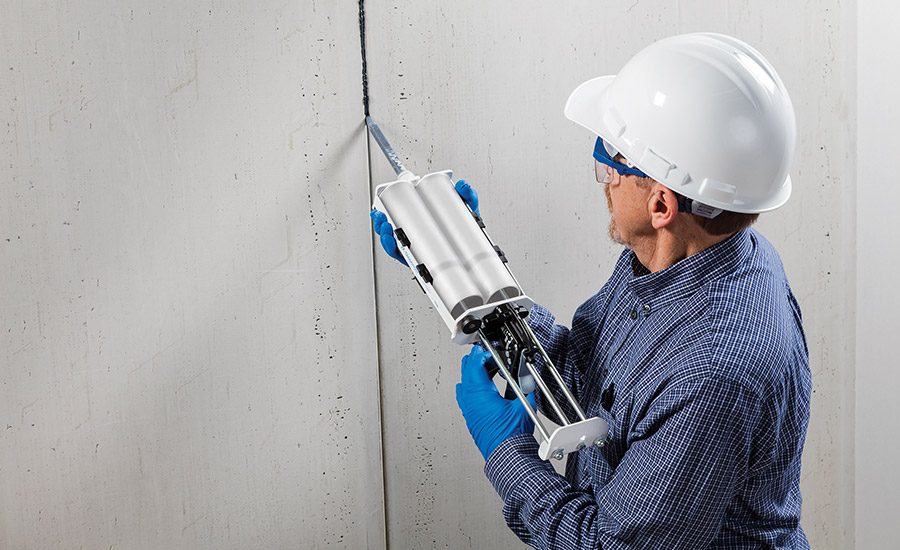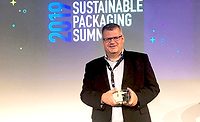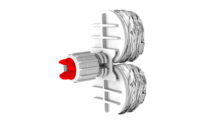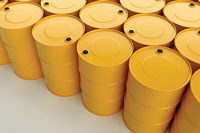Collapsible Two-Component Adhesives and Sealants Packaging Supports Sustainability Efforts
In addition to supporting sustainability by reducing plastic waste, collapsible film-based cartridges feature improved fluid packaging and dispensing performance.


Seven fully-compressed collapsible cartridges can replace one standard side-by-side cartridge in landfills.

A reusable retainer with integrated plungers allows the cartridges to easily drop into standard two-component dispense guns.





One of the latest developments to impact two-component fluid dispensing performance and waste reduction is the release of side-by-side, collapsible film-based cartridges.* These cartridges can be used in industrial, automotive, marine, and construction applications for two-part materials such as: foams; coatings; potting compounds; and other adhesives and sealants. Delivering the same quality mix performance as standard, high-precision 2K rigid cartridge systems, collapsible cartridges occupy less space in landfills than conventional rigid cartridges.
*Film-Pak® cartridges from Nordson EFD.
Supporting Sustainability
When conventional rigid, side-by-side cartridges are empty, the entire cartridge—both chambers and plungers—becomes waste and must be disposed of. When film-based collapsible packages are empty, they compress into a lid, which must also be disposed of as waste. Seven fully-compressed collapsible cartridges replace one standard side-by-side cartridge in landfills.
Effectively, this means that film-based collapsible cartridges yield an 85% reduction in packaging waste volume for the same amount of fluid dispensed compared to conventional 2K cartridges. This contributes to a significantly reduced carbon footprint while supporting corporate sustainability and lowering waste disposal costs.
Beyond its sustainability benefits, the collapsible cartridge incorporates multiple design features to maintain fluid integrity and facilitate reliable dispensing and packaging:
- A multi-layer film, including an aluminum layer for improved barrier properties against oxygen and moisture permeation, which can otherwise shorten fluid shelf life; this allows users to reduce waste without sacrificing shelf-life stability
- The film is integrally bonded to the lid, providing a leak-proof connection and encapsulating the inner film layers to prevent chemical degradation (utility patent in place)
- The film streamlines fluid packaging inventory for fluid formulators because it is inert to most adhesives and sealants; conventional side-by-side cartridges require stock in nylon, polypropylene, and high-density polyethylene, depending on the material being filled
- The ability to fill the film-based cartridges through the outlets or ports on the lid simplifies filling procedures; outlets allow for fast, easy filling of low-viscosity fluids while ports on the lids allow for fast, easy filling of high-viscosity fluids
- Resealable outlets allow material to be stored for future use if not completely dispensed; this allows fluid to be completely dispensed prior to disposal, reducing fluid waste
- The design of the cartridge also makes it compatible with a wide range of static mixers, including a disposable square mixer** that optimizes mix performance in a 20% shorter length than conventional mixers; the shorter length of square mixer further benefits sustainability efforts by reducing retained volume by 30%, which reduces fluid waste
**OptiMixer™ from Nordson EFD.
Application Versatility
Although specialized 2K dispense guns have been designed, the film-based cartridge system can also be used with existing manual, pneumatic, and battery-operated dispense guns (including pneumatic guns for high-pressure spray applications), making it a versatile solution for 2K dispensing. A reusable retainer (i.e., sleeve or shuttle) with integrated plungers allows the cartridges to easily drop into standard two-component dispense guns. The specialized guns eliminate the need for the separate reusable retainer.
Performance Validation
The side-by-side, collapsible film-based cartridge was extensively tested for compatibility with epoxies, polyurethanes, and methyl methacrylates (MMAs). Multiple aspects were tested for conditions such as material compatibility over time, drool performance, retained volume, flow rate, and burst strength (see Table 1). Most tests were conducted in comparison to standard 300 x 300 ml rigid cartridges; one test evaluated performance against sausage-type packaging.
Package Integrity
Multi-layer film testing showed package integrity after 18 weeks of accelerated age testing. The film-based package remained fully intact, without degradation of the layers.
Material Shelf Life
Accelerated age testing was also employed to evaluate material shelf life. Exotherm testing was performed after 30 days at 60°C (140°F). The collapsible film-based cartridge was compared to rigid side-by-side cartridges filled with the same material. This comparative testing included both newly filled cartridges (as a baseline) and cartridges after accelerated aging. Beads were dispensed, and temperature readings were taken every 10 sec until cured.
The results showed no difference between the new material and the material exposed to the accelerated ageing for both film-based and rigid cartridges. There was no degradation of material integrity in the film-based cartridge as compared to standard cartridges.
MMA Weight Loss
Methyl methacrylate monomer weight loss testing was conducted with the new collapsible cartridge vs. nylon film packaging and measured at periodic intervals for 84 days. The new system showed less weight loss than conventional nylon film, indicating its suitability for use with MMAs.
Drool
The engineering team conducted a series of drool comparison tests using standard 300 x 300 ml rigid cartridges vs. 300 x 300 ml film-based cartridges filled at the same time with the same material, then dispensed. All testing showed that the film-based cartridges performed at a 65-75% reduction in drool when compared to standard rigid cartridges. Essentially, as the film relaxes it reduces the pressure, which likewise reduces the tendency for material to continue to flow from the cartridge.
Retained Volume
The new collapsible cartridge was tested vs. standard rigid cartridges of the same size, as well as 330-ml sausage-type packaging for retained volume. Testing was performed with both 30,000 centipoise and 100,000 centipoise material.
Empty packaging was weighed at the start, then filled and dispensed. The dispensed packages were then weighed at the end. The film-based cartridge showed a 1% increase in retained material volume compared to the rigid cartridges, but 70% less retained material volume when compared to the sausage-type packaging.
Flow Rate
In comparing the collapsible cartridge to conventional rigid cartridges, testing was done to determine the flow rate of dispensed material, both aged and virgin, coming out of the nozzle to see if there was any effect through accelerated ageing of either the “A” or “B” material. Five filled rigid and collapsible cartridges were dispensed immediately, with the flow rates measured. Another five each were aged for 30 days at 60°C and then dispensed; their flow rates were measured.
The results showed that the film-based cartridge had a lower flow rate when compared to standard cartridges. For applications requiring higher dispense rates, users of the collapsible cartridges would need to increase gun force or use a higher-capacity gun.
Burst Strength
To ensure the film-based cartridge could maintain a high level of structural integrity, engineers conducted extensive testing with various materials of differing viscosity and at different pressure levels. Even under constant dispense force of 100 psi and with the “A” and “B” materials having very different viscosities, the packaging maintained its structural integrity.
Optimizing 2K Dispense Performance
Collapsible, film-based cartridges are more than a sustainable choice for fluid packaging. In addition to reducing plastic packaging waste volume by more than 85%, these cartridges reduce drool by up to 75% when compared to standard, rigid cartridges and retain 70% less material volume than sausage-type packaging. They streamline inventory and fit into any standard two-component dispense gun, including manual, pneumatic, and cordless or battery-operated.
For more information, contact the author at (860) 889-3383 or peter.kuzyk@nordsonefd.com, or visit www.nordsonefd.com.
Editor’s note: This article is based on a presentation given at the Adhesive and Sealant Council’s 2019 Annual Spring Conference and Expo. For details regarding the council and its events, visit www.ascouncil.org.
Looking for a reprint of this article?
From high-res PDFs to custom plaques, order your copy today!









